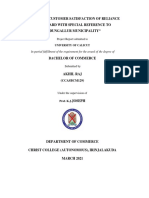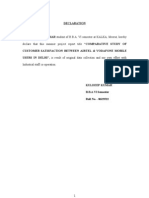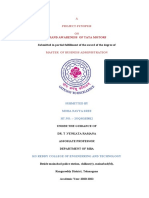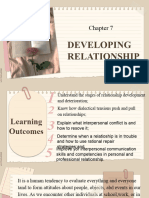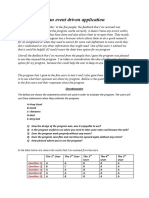0 ratings0% found this document useful (0 votes)
183 viewsBrand Image - Airtel
Brand Image - Airtel
Uploaded by
Kitten KittyThis document provides a project report on the brand image of Bharti Airtel Limited. The objectives are to study Airtel's brand and image, understand customer satisfaction with services, and identify gaps between customer needs and offerings. The methodology includes a questionnaire survey of 100 customers in Hyderabad to collect primary data on Airtel's market share and future plans. Secondary data comes from company brochures, books on branding, and the Airtel website. The analysis uses percentages to understand customer perceptions of Airtel's brand image.
Copyright:
© All Rights Reserved
Available Formats
Download as DOCX, PDF, TXT or read online from Scribd
Brand Image - Airtel
Brand Image - Airtel
Uploaded by
Kitten Kitty0 ratings0% found this document useful (0 votes)
183 views8 pagesThis document provides a project report on the brand image of Bharti Airtel Limited. The objectives are to study Airtel's brand and image, understand customer satisfaction with services, and identify gaps between customer needs and offerings. The methodology includes a questionnaire survey of 100 customers in Hyderabad to collect primary data on Airtel's market share and future plans. Secondary data comes from company brochures, books on branding, and the Airtel website. The analysis uses percentages to understand customer perceptions of Airtel's brand image.
Original Description:
BRAND IMAGE-----AIRTEL
Original Title
BRAND IMAGE-----AIRTEL
Copyright
© © All Rights Reserved
Available Formats
DOCX, PDF, TXT or read online from Scribd
Share this document
Did you find this document useful?
Is this content inappropriate?
This document provides a project report on the brand image of Bharti Airtel Limited. The objectives are to study Airtel's brand and image, understand customer satisfaction with services, and identify gaps between customer needs and offerings. The methodology includes a questionnaire survey of 100 customers in Hyderabad to collect primary data on Airtel's market share and future plans. Secondary data comes from company brochures, books on branding, and the Airtel website. The analysis uses percentages to understand customer perceptions of Airtel's brand image.
Copyright:
© All Rights Reserved
Available Formats
Download as DOCX, PDF, TXT or read online from Scribd
Download as docx, pdf, or txt
0 ratings0% found this document useful (0 votes)
183 views8 pagesBrand Image - Airtel
Brand Image - Airtel
Uploaded by
Kitten KittyThis document provides a project report on the brand image of Bharti Airtel Limited. The objectives are to study Airtel's brand and image, understand customer satisfaction with services, and identify gaps between customer needs and offerings. The methodology includes a questionnaire survey of 100 customers in Hyderabad to collect primary data on Airtel's market share and future plans. Secondary data comes from company brochures, books on branding, and the Airtel website. The analysis uses percentages to understand customer perceptions of Airtel's brand image.
Copyright:
© All Rights Reserved
Available Formats
Download as DOCX, PDF, TXT or read online from Scribd
Download as docx, pdf, or txt
You are on page 1of 8
A
Project Report
ON
“BRAND IMAGE”
With
“BHARTI AIRTEL LIMITED”
Submitted in partial fulfillment of the requirement for the award of the degree
of
“MASTER OF BUSINESS ADMINISTRATION”
(Marketing)
Submitted By
MUFEEZ AHMED
1077-20-672-101
Under the guidance of
Mr. AMJAD KHAN
(ASSOCIATE PROFESSOR)
DECCAN SCHOOL OFMANAGEMENT
(Affiliated to Osmania University-HYDERABAD)
(2020-2022)
INTRODUCTION
Branding
“The act of giving a company a particular design or symbol in order to advertise its products
and services” from Cambridge Advanced Learner’s Dictionary
A brand is a name, sign, symbol, slogan or anything that is used to identify and distinguish
a specific product, service, or business. A legally protected brand name is called a proprietary
name.
Brand is the image of the product in the market. Some people distinguish the psychological
aspect of a brand from the experiential aspect. The experiential aspect consists of the sum of
all points of contact with the brand and is known as the brand experience. The psychological
aspect, sometimes referred to as the brand image, is a symbolic construct created within the
minds of people and consists of all the information and expectations associated with a
product or service.
People engaged in branding seek to develop or align the expectations behind the brand
experience, creating the impression that a brand associated with a product or service has
certain qualities or characteristics that make it special or unique. A brand is therefore one of
the most valuable elements in an advertising theme, as it demonstrates what the brand owner
is able to offer in the marketplace. The art of creating and maintaining a brand is called brand
management. Orientation of the whole organization towards its brand is called brand
orientation.
Careful brand management seeks to make the product or services relevant to the target
audience. Therefore cleverly crafted advertising campaigns, can be highly successful in
convincing consumers to pay remarkably high prices for products which are inherently
extremely cheap to make. This concept, known as creating value, essentially consists of
manipulating the projected image of the product so that the consumer sees the product as
being worth the amount that the advertiser wants him/her to see, rather than a more logical
valuation that comprises an aggregate of the cost of raw materials, plus the cost of
manufacture, plus the cost of distribution. Modern value-creation branding-and-advertising
campaigns are highly successful at inducing consumers to pay, for example, 50 dollars for a
T-shirt that cost a mere 50 cents to make, or 5 dollars for a box of breakfast cereal that
contains a few cents' worth of wheat.
Brands should be seen as more than the difference between the actual cost of a product and
its selling price - they represent the sum of all valuable qualities of a product to the consumer.
There are many intangibles involved in business, intangibles left wholly from the income
statement and balance sheet which determine how a business is perceived. The learned skill
of a knowledge worker, the type of metal working, the type of stitch: all may be without an
'accounting cost' but for those who truly know the product, for it is these people the company
should wish to find and keep, the difference is incomparable. Failing to recognize these assets
that a business, any business, can create and maintain will set an enterprise at a serious
disadvantage.
A brand which is widely known in the marketplace acquires brand recognition. When brand
recognition builds up to a point where a brand enjoys a critical mass of positive sentiment in
the marketplace, it is said to have achieved brand franchise. One goal in brand recognition
is the identification of a brand without the name of the company present. For example,
Disney has been successful at branding with their particular script font (originally created for
Walt Disney's "signature" logo)
Consumers may look on branding as an important value added aspect of products or services,
as it often serves to denote a certain attractive quality or characteristic (see also brand
promise). From the perspective of brand owners, branded products or services also command
higher prices. Where two products resemble each other, but one of the products has no
associated branding (such as a generic, store-branded product), people may often select the
more expensive branded product on the basis of the quality of the brand or the reputation of
the brand owner.
NEED OF THE PROJECT
The basic need of the project is to understand the service of BHARTI AIRTEL
LIMITED products and identify what are the gaps in service. The idea behind the projects is
to identify what is the brand and service range of BHARTI AIRTEL LIMITED products in
Hyderabad market.
Company wants to know whether service process working properly or not? And are retailers
satisfied with the service practice? Company also wants to distinguish the availability of
BHARTI AIRTEL LIMITED products and visibility in market through promotional
materials.
The need of project arises from company to improve its service practice in order to have
better market placement in Hyderabad market. So, for that they needed in-depth analysis of
the problems which would also generate some fresh ideas for the improvement.
OBJECTIVES OF THE STUDY
● To study about the AIRTEL BRAND.
● To know about the brand image of AIRTEL Tele services.
● To know how customers feel about AIRTEL TELE SERVICES
● Are they happy with the service?
● To know about what customer needs and what the company is providing.
SCOPE OF THE STUDY
The study is conducted within Hyderabad town and its various parts. Hyderabad was
divided in two regions which are one town and two Town. The survey is conducted in
Automobile shops situated in all regions which are exclusive in sales of BHARTI AIRTEL
LIMITED.
RESEARCH METHODOLOGY
Definition:
Research methodology is the specification of the method of acquiring the information
needed to the structure or to solve the problem at hand.
It is the pattern of the framework of the project that stipulates what information is to
be collected, from which source and by what method.
Primary Source Data:
A questionnaire was prepared helped in gaining an insight view of the factors
effecting the customer needs and related issues. The addresses of various customers were
given and with the help of the questionnaire prepared, I need to find out the first hand
information regarding the share of the Airtel in every segment in the market and the
satisfaction level of each customer. Further I need to find out the future plans of the customer
regarding the purchase of the Airtel products.
Each day I met 5 customers for 4 weeks the sample size of 100 respondents was
decided upon.
Secondary Data:
Secondary data collection method includes
● Data collected from Broachers and materials provided by Bharthi Airtel Ltd.
● Various books relating to Brand Image and other related topics
● Various information from the official website of Airtel
Sampling Procedure:
The sampling technique use here was Quota Sampling, which is one of the most commonly
used non-probability sample design.
Sampling Unit:
The target population from which the sample is chosen is owners of all brands of Sim cards.
Sample Size:
The sample of 100 from the target population was chosen.
Analysis Used:
The data collected in form of questionnaires was tabulated and analyzed using basic
statistical method percentages.
You might also like
- Dissertation R Transportation Problems in Metros and Urban CitiesDocument58 pagesDissertation R Transportation Problems in Metros and Urban CitiesSejuti SarkarNo ratings yet
- Anatomy Syllabus Fall 2015 Sec 0001and HonorsDocument10 pagesAnatomy Syllabus Fall 2015 Sec 0001and HonorskarijaniNo ratings yet
- MBA 7000 People and Organisation Assignment 1Document7 pagesMBA 7000 People and Organisation Assignment 1SachiniNo ratings yet
- Checklist of Mov For RPMS PortfolioDocument3 pagesChecklist of Mov For RPMS Portfolioallan jake89% (9)
- 2 - TOGAF 9 Part 1 Practice Test - Nov2012Document41 pages2 - TOGAF 9 Part 1 Practice Test - Nov2012swapnil_bankar100% (3)
- Study On Consumer Perference On Amazon and FlipkartDocument51 pagesStudy On Consumer Perference On Amazon and FlipkartSimran JaiswalNo ratings yet
- A Study On Customer Perception of Airtel Broadband Services Among Small Medium EnterprisesDocument72 pagesA Study On Customer Perception of Airtel Broadband Services Among Small Medium EnterprisesAkshada VinchurkarNo ratings yet
- SDM Final Project Report - AirtelDocument32 pagesSDM Final Project Report - AirtelSazid HassanNo ratings yet
- SR No. Particulars Page No.: 2. Title, Objective& Scope of The ProjectDocument42 pagesSR No. Particulars Page No.: 2. Title, Objective& Scope of The Projectj_sachin09No ratings yet
- Marketing Research On CSAT at Airtel - BBA Marketing Summer Training Project ReportDocument82 pagesMarketing Research On CSAT at Airtel - BBA Marketing Summer Training Project ReportNischal DattatreyaNo ratings yet
- T Bharti DissertationDocument42 pagesT Bharti DissertationPratik MitraNo ratings yet
- Dissertation Report-Chiranjit KamilyaDocument40 pagesDissertation Report-Chiranjit KamilyaChiranjit KamilyaNo ratings yet
- ADVERTISINGDocument12 pagesADVERTISINGMaharajascollege KottayamNo ratings yet
- Banking TechnologyDocument10 pagesBanking Technologyjavaid IqbalNo ratings yet
- Marketing Strategy of AirtelDocument92 pagesMarketing Strategy of AirtelAnmol Arora0% (1)
- Project VarshithaDocument74 pagesProject VarshithaChandrika ChamsNo ratings yet
- Share GROTH OF PAYTMDocument73 pagesShare GROTH OF PAYTMTYBMS B 3177 MAHIMARAJ DURAISAMYNo ratings yet
- Unimart ExpressDocument67 pagesUnimart ExpressNaij ahmedNo ratings yet
- Research Corporate Governance of GATI LTDDocument33 pagesResearch Corporate Governance of GATI LTDUntuak Film100% (1)
- HHHHDocument64 pagesHHHHRohit BhandariNo ratings yet
- Merit-Trac: A Test in Everyone's LifeDocument24 pagesMerit-Trac: A Test in Everyone's LifeNitin Nair100% (2)
- Aaron MPR TextileDocument54 pagesAaron MPR TextileIshvinder Singh KalraNo ratings yet
- 1NH20BA159Document103 pages1NH20BA159MADHURI RATHORENo ratings yet
- A Study On Customer Satisfaction of Reliance Jio Simcard With Special Reference To Kodungallur MunicipalityDocument66 pagesA Study On Customer Satisfaction of Reliance Jio Simcard With Special Reference To Kodungallur MunicipalityDinesh SirviNo ratings yet
- Project Ameen 1 51Document51 pagesProject Ameen 1 51alameen asharNo ratings yet
- Vodafone Idea BRMDocument11 pagesVodafone Idea BRMMehul TankNo ratings yet
- Patanjali Ayurved Limited MAP ReportDocument95 pagesPatanjali Ayurved Limited MAP ReportJhanvi GandhiNo ratings yet
- A Study On Various Banking Service Factors Influencing To HNI/Premium Customers BehavioursDocument6 pagesA Study On Various Banking Service Factors Influencing To HNI/Premium Customers BehavioursAshutosh KumarNo ratings yet
- Reasons For Failure of Virgin MobilesDocument23 pagesReasons For Failure of Virgin MobilesKaran Khanna100% (1)
- MPR Vansh Goel BingoDocument65 pagesMPR Vansh Goel BingoVansh GoelNo ratings yet
- Shaikh Humera New BLACK BOOK 123Document62 pagesShaikh Humera New BLACK BOOK 123shaikh saudNo ratings yet
- A Study On Financial Performance of The RAMCO Cements Ltd-1237 PDFDocument5 pagesA Study On Financial Performance of The RAMCO Cements Ltd-1237 PDFNagaveni MNo ratings yet
- Summer Training Project Report ON: Submitted byDocument55 pagesSummer Training Project Report ON: Submitted byVivian Clement100% (2)
- E Business Replacing Traditional Business ModelsDocument16 pagesE Business Replacing Traditional Business ModelsRohan Sinha0% (1)
- Commerce - A Study On The Online Retailing On AmazonDocument40 pagesCommerce - A Study On The Online Retailing On AmazonChandan SantukaNo ratings yet
- AREEBADocument107 pagesAREEBAManjeet SinghNo ratings yet
- A Project Report On AmulDocument44 pagesA Project Report On AmulroselinNo ratings yet
- STPRDocument97 pagesSTPRsatyamtiwari44003No ratings yet
- Minor Project Report ON Marketing Strategy of AmulDocument47 pagesMinor Project Report ON Marketing Strategy of AmulRAHUL MAURYANo ratings yet
- Project Report On The Genesis of Hindustan Unilever Limited (HUL)Document44 pagesProject Report On The Genesis of Hindustan Unilever Limited (HUL)swapnil panmandNo ratings yet
- Dissertation ProjectDocument10 pagesDissertation Projectvishal rathiNo ratings yet
- Comparative Study of Customer Satisfaction Between Airtel & Vodafone Mobile Users in DelhiDocument98 pagesComparative Study of Customer Satisfaction Between Airtel & Vodafone Mobile Users in Delhilokesh_045100% (1)
- UntitledDocument96 pagesUntitledOmkar VichareNo ratings yet
- UploadedDocument30 pagesUploadedSumit ShawNo ratings yet
- Myntra: Plan To Venture Into The BPC MarketDocument7 pagesMyntra: Plan To Venture Into The BPC MarketShashank PullelaNo ratings yet
- A Study On Customer Satisfaction at CielDocument87 pagesA Study On Customer Satisfaction at Cielganesh rajNo ratings yet
- Ahmed Mba ProjectDocument63 pagesAhmed Mba ProjectSandesh GajbhiyeNo ratings yet
- Sahana Parvin - Dissertation ReportDocument29 pagesSahana Parvin - Dissertation Reportswarnagopal dasNo ratings yet
- Bharti AirtelDocument14 pagesBharti AirtelShweta ChaturvediNo ratings yet
- A Project Report On How Digital Marketing AffectsDocument68 pagesA Project Report On How Digital Marketing AffectsRishi JainNo ratings yet
- Prajkta BBA Marketing ProjectDocument29 pagesPrajkta BBA Marketing ProjectPratik BhujbalNo ratings yet
- Abhishek KesaryDocument49 pagesAbhishek KesaryVARSHA BHOJWANINo ratings yet
- Paras Major Project BBA 6 Sem-2Document31 pagesParas Major Project BBA 6 Sem-2Abhinav KumarNo ratings yet
- Jio InfocommDocument4 pagesJio Infocommpm278No ratings yet
- Display AdvertisementDocument50 pagesDisplay AdvertisementMohit UpadhyayNo ratings yet
- Synopsis of Bharti AirtelDocument16 pagesSynopsis of Bharti AirtelAnnie JosephNo ratings yet
- Zomato & SwiggyDocument20 pagesZomato & SwiggyShrut JabuaniNo ratings yet
- Major Research Project Consumer Perception Towards Online ShoppingDocument48 pagesMajor Research Project Consumer Perception Towards Online ShoppingHarsha OjhaNo ratings yet
- Farhan Raza Khan 11Document49 pagesFarhan Raza Khan 11Ritik Rana (Mr.x)100% (1)
- A Study of Marketing Campaigns of Upstox Through Various MediaDocument40 pagesA Study of Marketing Campaigns of Upstox Through Various Mediarohan patilNo ratings yet
- 2M00733 - Mms Mumbai University Result Sem 3 2023Document887 pages2M00733 - Mms Mumbai University Result Sem 3 2023anammominNo ratings yet
- Market Research of Carray CartDocument22 pagesMarket Research of Carray CartBharath MBNo ratings yet
- A Study On Customer Satisfaction Towards Recruitment & Selection Process in (Ma Foi) Ciel HR Services Pvt. LTD in MaduraiDocument82 pagesA Study On Customer Satisfaction Towards Recruitment & Selection Process in (Ma Foi) Ciel HR Services Pvt. LTD in MaduraiEban AnburajNo ratings yet
- Vaishnav IDocument8 pagesVaishnav Imohammed khayyumNo ratings yet
- Capital Structure - AmbujaDocument14 pagesCapital Structure - AmbujaKitten KittyNo ratings yet
- BRAND PREFERENCE TOWARDS SOFT DRINKS at Coca-ColaDocument10 pagesBRAND PREFERENCE TOWARDS SOFT DRINKS at Coca-ColaKitten KittyNo ratings yet
- Mora Navya Sree - SynopsisDocument9 pagesMora Navya Sree - SynopsisKitten KittyNo ratings yet
- Non Performing Assets - IdbiDocument7 pagesNon Performing Assets - IdbiKitten KittyNo ratings yet
- Cost Analysis and Control - HyundaiDocument8 pagesCost Analysis and Control - HyundaiKitten KittyNo ratings yet
- Rural Marketing at HeritageDocument9 pagesRural Marketing at HeritageKitten KittyNo ratings yet
- Hris - Heritage - SYNOPSISDocument8 pagesHris - Heritage - SYNOPSISKitten Kitty0% (1)
- A Project Report On Health InsuranceDocument5 pagesA Project Report On Health InsuranceKitten KittyNo ratings yet
- Honourable Sri Justice M.S.Ramachandra Rao AND Honourable Sri Justice T.Vinod KumarDocument21 pagesHonourable Sri Justice M.S.Ramachandra Rao AND Honourable Sri Justice T.Vinod KumarKitten KittyNo ratings yet
- Chapter-Iii Industry Profile & Company ProfileDocument19 pagesChapter-Iii Industry Profile & Company ProfileKitten KittyNo ratings yet
- Lesson 25 Robotics - Colour SensorDocument4 pagesLesson 25 Robotics - Colour Sensorapi-352881693No ratings yet
- CV Samarth IITG PDFDocument2 pagesCV Samarth IITG PDFshivamadm2021No ratings yet
- LMS and CMSDocument14 pagesLMS and CMSlakshmipriyaNo ratings yet
- Philippine Tourism, Geography, and CultureDocument4 pagesPhilippine Tourism, Geography, and CultureTristan Troy CuetoNo ratings yet
- GISMA Information Pack 2019-2020 UpdatedDocument17 pagesGISMA Information Pack 2019-2020 UpdatedZahidul Islam RazuNo ratings yet
- Bihar Combined Entrance Competitive Examination BoardDocument4 pagesBihar Combined Entrance Competitive Examination BoardsupersafetyindustryNo ratings yet
- Adapting Courses - Group 2Document18 pagesAdapting Courses - Group 2Bảo NgọcNo ratings yet
- Purposive Developing RelationshipkristineDocument9 pagesPurposive Developing RelationshipkristineMampusti MarlojaykeNo ratings yet
- Junior English SyllabusDocument4 pagesJunior English Syllabusapi-296236812No ratings yet
- Floating Point ProcessorDocument5 pagesFloating Point Processormoha7178No ratings yet
- Climbing GuideDocument20 pagesClimbing GuideWiryanto Chandra100% (4)
- Richardson ResumeDocument3 pagesRichardson Resumeapi-549248694No ratings yet
- Duality ModuleDocument16 pagesDuality ModuleJanet GravilesNo ratings yet
- GTM & DMDocument5 pagesGTM & DMShinta Ari HerdianaNo ratings yet
- PED1 REVIEWER FinalsDocument11 pagesPED1 REVIEWER Finalsfernandeztrisha624No ratings yet
- Chapter 1-3Document26 pagesChapter 1-3Jemimah Ruth Madayag Valenzuela100% (1)
- SAI-DG Newsletter: What's New Welcome BackDocument6 pagesSAI-DG Newsletter: What's New Welcome Backapi-393035660No ratings yet
- Perils and Pitfalls of Leading ChangeDocument6 pagesPerils and Pitfalls of Leading ChangeNADEEM SIDD0% (1)
- Open Section - First Round - SMO Singapore Mathematical Olympiad 2010Document4 pagesOpen Section - First Round - SMO Singapore Mathematical Olympiad 2010Robert HarryNo ratings yet
- General Academic StrandDocument3 pagesGeneral Academic StrandJehan IbrahimNo ratings yet
- CHAPTER 12 Roles and Competencies of School Heads3Document15 pagesCHAPTER 12 Roles and Competencies of School Heads3mnbv vbnm60% (5)
- D3 - Evaluate An Event Driven Application: QuestionnaireDocument2 pagesD3 - Evaluate An Event Driven Application: QuestionnaireAndrei2k10No ratings yet
- Essay Questions MBADocument4 pagesEssay Questions MBAVishnu DuraisamyNo ratings yet
- AI in The Web of Science - May2024Document27 pagesAI in The Web of Science - May2024abdobharchiNo ratings yet
- Product Development Engineer Job Ad - 2024Document2 pagesProduct Development Engineer Job Ad - 2024rohit411004No ratings yet
- The Power of A Praying ChildDocument26 pagesThe Power of A Praying ChildMarvelous OlaNo ratings yet























